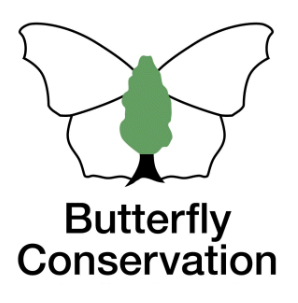Brown Argus
Brown Hairstreak
Chalkhill Blue
Clouded Yellow
Comma
Common Blue
Dark Green Fritillary
Dingy Skipper
Essex Skipper
Gatekeeper
Green Hairstreak
Green-veined White
Grizzled Skipper
Holly Blue
Large Skipper
Large White
Marbled White
Meadow Brown
Orange-tip
Painted Lady
Peacock
Purple Emperor
Purple Hairstreak
Red Admiral
Ringlet
Silver-washed Fritillary
Small Blue
Small Copper
Small Heath
Small Skipper
Small Tortoiseshell
Small White
Speckled Wood
Wall
White Admiral
White-letter Hairstreak
Extinct/rare immigrants
Gatekeeper
Pyronia tithonus
General Distribution and Status
The Gatekeeper is widespread and common in England, except the far north, and Wales but its range is gradually expanding northwards. The reason for the expansion is probably due to climate change as the butterfly's habitat type is found throughout the country. The removal of hedgerows and fewer field margin habitats had affected this butterfly in the last century most especially in the arable east of England (Asher et al.) . However, since the 1970s expansion has taken place, albeit at a slow rate, but abundance at monitored sites has declined by over a third (Brereton et al.). In Hertfordshire and Middlesex, there has been a very slight expansion in range but with numbers on transect sites decreasing at a similar rate (Wood, 2016) and although 2019 and 2023 were good years numbers are still falling.
| United Kingdom | Herts & Middx | |||
| Distribution | 1976-2019 | +2% | 1980-2015 | +14% |
| Average 10-year trend | +0.4% | 2006-2015 | +23% | |
| 2024 since 2015-19 | +17% | |||
| Abundance | 1976-2024 | -38% | 1980-2015 | -35% |
| 2015-2024 | +32% | 2006-2015 | -39% | |
| 2023-2024 | -40% | 2024 since 2015-19 | -20% | |
UK distribution map
UKBMS Species summary
Habitat Requirements
This species is a butterfly of hedgerows, woodland rides and scrubland containing tall grasses. Heaths, under cliffs and downland sites are also visited if they contain scrub.
Larval Foodplants
Cock's-foot Dactylis glomerata, Annual Meadow-grass Poa annua, Rough Meadow-grass Poa trivialis, Sheep's Fescue Festuca ovina, Creeping Bent Agrostis stolonifera, Rye-grass Lolium spp.. Common Couch Elytrigia repens is also noted by Sawford.
Adult Food Sources
Bramble Rubus fruticosus agg. (748), Wild Marjoram Origanum vulgare (206), Buddleia Buddleja davidii (174), Common Ragwort Senecio jacobaea (166), Heather Calluna vulgaris (135).
Historical Records
The butterfly seems to have been common, and abundant in some years, throughout the 20th century with no apparent evidence of any significant decline during any period.
Local Distribution and Abundance
The Gatekeeper occurs widely in the Stevenage area. 2023 was the best year during the survey in terms of number of reports with 146 specimens counted during a Wider Countryside Butterfly Survey in the Knebworth Woods complex on 10 July but generally abundance is proportionally now lower than in the past. Hundreds were regularly seen in the late 1990s and the early part of this century in this area. The highest count recorded is an estimated 500 at Knebworth Park on 25 July 2001.

Stevenage (South Fairlands Valley Park) transect 1993-2025
The pattern of abundance reflects generally what is occurring elsewhere. The peak in 2004 is pronounced because the conditions in Millennium Wood were ideal for the butterfly in that year. The woodland was previously improved grassland but in late 1999 hundreds of saplings, mostly of oak, were planted and the area was left unmanaged. By 2004, enough scrub had grown in the wood but still with sufficient light and warmth for the butterfly to thrive. However, in subsequent years, the area had become more overgrown and very few Gatekeepers are now seen in this part of the transect. More than half the numbers on the transect in 2004 were found in Millennium Wood, for example, 112 on 31 July against a total of 195. Undoubtedly some specimens dispersed to other areas of the park but the decline in recent years is mostly due to the loss of habitat in Millennium Wood and time will tell if the downward trend will continue. The poor showing in 2016, the worst during the survey with only 83 records can probably be attributed to cloudy conditions in that year. Very little improvement in subsequent years probably due to predominantly dry springs although the wet, cool spring and early summer in 2024 did not help this butterfly either. The warm and dry summer in 2025 saw the butterfly make a spectacular recovery with the highest numbers since 2009.

Knebworth Park transect 1996-2010 and 2017-2025
Since the peaks in 2004 and 2005, abundance has decreased alarmingly for this species. The counts since the transect was resumed in 2017 appear to suggest an ongoing downward trend. The north-western part of the park is the best area for this species.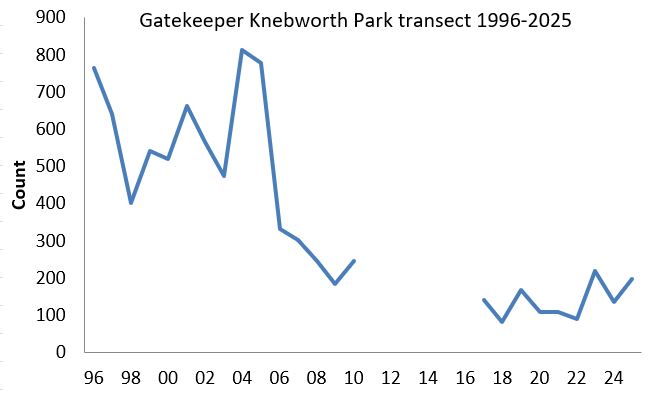
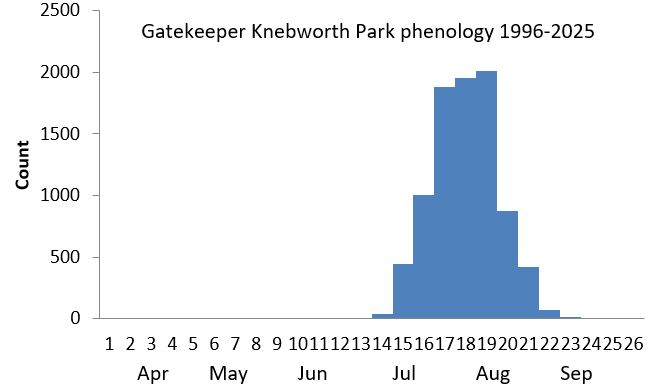
Knebworth Woods transect 2017-2025
2019 was the best year after a poor season in 2018 but numbers fell back in 2020 probably due to the effects of the drought in the spring. Fluctuating fortunes since 2020 but a record number overall was seen in 2025. Norton Green Common is the best site to look for this butterfly.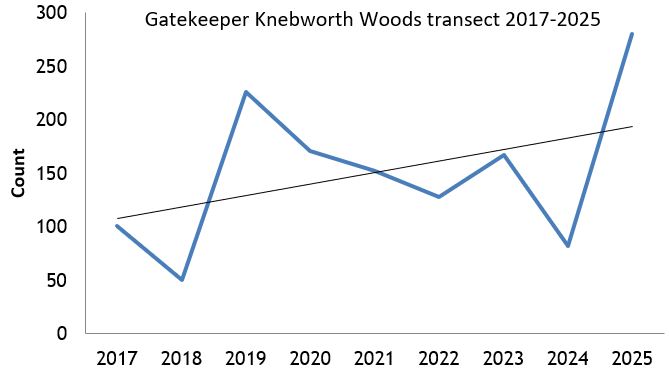
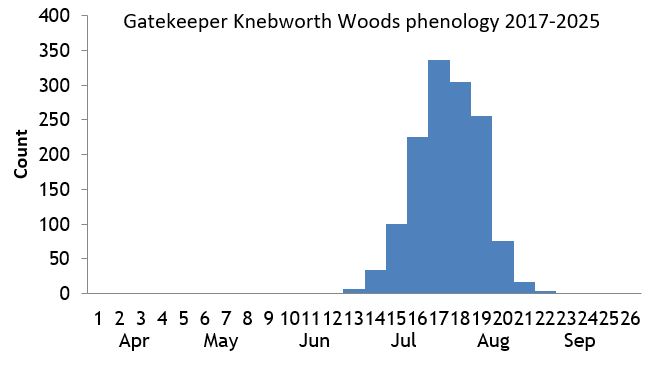
Pryor's Wood transect 2000-2022
As with the other transects the species showed a decline in the early part of this decade and although there were reports of the butterfly in 2015 and 2016 after a four-year gap there were no sightings in 2017 and 2018. It was seen on three separate occasions in both 2019 and 2020 but none in 2021 and 2022. The best year was 2003 with 24 individuals and the highest count for a single visit was on 30 July 2001 when 12 were recorded.Life History
Earliest date: 21 June 2022 at Hitchin
Latest date: 10 September 2007 at Knebworth
Park
Only one generation is produced each year. The butterfly's emergence begins in early July and lasts until the end of August with a few stragglers
left in September. The peak usually occurs in the last week of July and first week of August. Eggs are laid singly on grasses in warm and sheltered situations
but usually in shade. Larvae soon enter hibernation when they emerge. In the spring the larvae feed on the tenderest parts of grass before forming a pupa low down
when fully grown.
Behaviour/Observation notes
The Gatekeeper is often found basking on flowers for long periods in sunlit places and is an easy butterfly to photograph. The female can be confused with the female Meadow Brown for inexperienced observers. Although in most cases, the Gatekeeper has two white pupils in the eye-spots on the forewings and the Meadow Brown has only one, the differences on the hindwings are more reliable to distinguish between the two species. The upperside of the Gatekeeper normally has a white-pupilled eye-spot and the underside a row of white dots.
Variations/Aberrations
Many variations and aberrations appear for this butterfly chiefly relating to the pattern and number of spots. One of the most
common aberrations is ab. excessa where one or more dark spots are found under the apical eyespot on the upperside forewings - see photo on the right.
I have found this aberration fairly common near Watery Grove. There is an increased proportion of this aberration in the west of England
(Barrington). The cloudier conditions in this part of the country may mean that the butterfly has to bask longer with wings wide open to attain optimum
body temperature. The extra spots may act as a defence mechanism against predation from birds. Locally, although 2017 saw about double the numbers of
Gatekeepers than in the previous two or three years not one ab. excessa was found. Did the fine and dry weather in the early summer of 2017 'normalise'
the development of the immature stages to produce more normal specimens? Aberration ab. albida is a form where the ground
colour is white and this has been seen in Hertfordshire. I saw an aberration where the hindwing spots are replaced by white blotches at Fairlands Valley Park in 2016.
Find out more on the UK Butterflies website
References

Norton Green Common 13 Jul 2019 (m)

Whomerley Wood 5 Aug 2016 (f)

Bishop's Stortford SCP 17 Jul 2017

ab. excessa Norton Green Common 21 Jul 2016 (m)

ab. Fairlands Valley Park 5 Aug 2016
